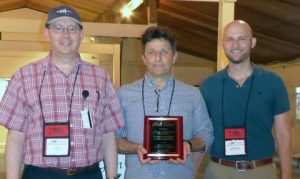A team comprising TWI Ltd and the SIMULIA brand of Dassault Systèmes has been awarded joint 1st Place: Best modelling results predicting the residual stresses within an as-built IN625 bridge structure – residual elastic strains (metals) in the 2018 Additive Manufacturing Benchmark (AM-Bench) Challenge organised by the U.S. National Institute of Standards and Technology (NIST). The following press release was published on the TWI website on September 6, 2018.
The team members were: Madie Allen, National Structural Integrity Research Centre (NSIRC) student at Brunel University London; Tyler London, Team Manager, Numerical Modelling and Optimisation, TWI Ltd, Yangzhan Yang, Americas R&D Customer Support Manager SIMULIA, Dassault Systèmes; and Victor Oancea, R&D Technology Director SIMULIA. Madie is currently undertaking a PhD with TWI on the numerical modelling of additive manufacturing, funded by Lloyd’s Register Foundation, and used the latest features of the Dassault Systèmes 3DEXPERIENCE platform and new finite element (FE) technology implemented in the SIMULIA Abaqus application in the submission. 
Additive manufacturing (AM) enables the production of three-dimensional metal and polymeric parts with intricate geometries that could not otherwise be produced using traditional manufacturing processes. However, the extreme thermal conditions generated during AM processing often result in distortion leading to dimensional inaccuracy, residual stresses that impact performance and undesirable micro-structures that can affect strength. In addition, accepted heat treatments, based on nominal compositions and equilibrium phase diagrams, are ineffective for many AM materials and can lead to functional issues and shorter service life.
As a result, and in combination with the rapid pace of AM technology and a lack of material property data, the need for a set of traceable standards and benchmark tests for the AM community was proposed at an AM National Academies workshop in Washington, D.C., organised by NIST. Consequently, the Additive Manufacturing Benchmark (AM-Bench) test series was created, backed by scientists and engineers from over 50 organisations, which led to the creation of the AM-Bench Challenge.
This inaugural Additive Manufacturing Benchmark (AM-Bench) Challenge introduced the first round of benchmark test challenges – for blind simulation predictions covering laser powder bed fusion and individual bare-plate laser traces for metals. There were over 40 entries to the international competition received from North America, Europe and Asia.
The particular challenge faced by the AM community is the ability to integrate and validate computer simulations and models, in particular for the prediction of distortion, residual stress and micro-structure evolution. While there have been many research developments and new software tools to address these areas, there has been a lack of publicly available, robust validation data.
The AM-Bench Challenge, therefore, seeks to address this gap through a continuing series of controlled benchmark tests, in conjunction with associated conferences, to allow modellers to test their simulations against rigorous, highly controlled, additive manufacturing benchmark test data. The intent of the series is to create a single set of rigorous benchmark tests that developers can make comparisons against, and produce results that will benefit the AM community.
Tyler London, TWI, speaking on behalf of the winning team, said “We are delighted to have won this prestigious award with Dassault Systèmes for our joint numerical modelling work on the prediction of additive manufacturing distortions and residual stresses.” “The NIST AM-Bench series is reminiscent of the old Batelle round-robin on crack opening displacement and the more recent NeT welding residual stress round-robin, both of which have resulted in significant engineering analysis advances in their respective areas” he went on to explain. “The AM-Bench also raised quite a few questions on certain aspects of AM modelling that we look forward to investigating in the future. As an industry-facing organisation, TWI hopes these validated simulation tools will improve the wider adoption and certification of AM parts.”
As final outputs, the team will prepare a paper based on their award winning work as well as incorporate what they have learned during the exercise into the development of future models for the additive manufacturing software industry.
Photograph shows Madie Allen, National Structural Integrity Research Centre (NSIRC) student at Brunel University London and Tyler London, Team Manager, Numerical Modelling and Optimisation, TWI Ltd, with the team’s AM-Bench Challenge award.
For more information, please contact us.
What to learn more about Dassault Systèmes’ simulation solutions for additive manufacturing? Visit: go.3ds.com/Print2Perform

